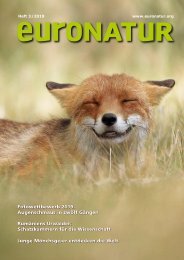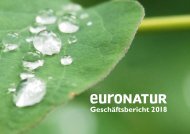Annual Report 2018 EuroNatur Foundation
Here you can get a good overview about our conservation programmes in Europe. Conatains also financial information.
Here you can get a good overview about our conservation programmes in Europe. Conatains also financial information.
Create successful ePaper yourself
Turn your PDF publications into a flip-book with our unique Google optimized e-Paper software.
Photo: LIFE Lynx - installing camera traps<br />
Photo: LIFE Lynx - transporting traps box<br />
Lynx from the Carpathians strengthen Dinaric population<br />
Geographical location in Europe<br />
Dinaric Alps in Italy, Slovenia and Croatia (Map p. 5,<br />
No. 22). Carpathian Mountains in Slovakia and Romania<br />
(Map p. 5, No. 20).<br />
Status<br />
While the Carpathian Mountains still host a sizeable lynx<br />
population, the Dinaric population has become so small<br />
and now has such low genetic variability that it is at risk<br />
of dying out sooner or later. In order to address this<br />
problem, a total of 14 lynx are to be caught in the Romanian<br />
and Slovakian Carpathians in order to release them into<br />
the wild in Croatia, Slovenia, and at the border with Italy.<br />
This “LIFE Lynx” project, which is financed by the European<br />
Union and supported by <strong>EuroNatur</strong>, involves foresters, hunters,<br />
scientists, veterinarians and conservationists from five<br />
countries. The activities do not however end with the animals’<br />
release into the wild. Many accompanying measures<br />
are needed such as, for example, avoiding conflicts with<br />
keepers of livestock, informing the public, lynx-friendly<br />
transport planning, and population monitoring.<br />
Objectives<br />
The aim is to augment the gene pool of the Dinaric lynx<br />
population and to bring this isolated population into<br />
contact with other lynx populations, especially the Alpine<br />
population. The long-term objective is to contribute to the<br />
reconnection of isolated lynx populations in Central and<br />
Western Europe.<br />
Selected activities in <strong>2018</strong><br />
Lynx tracks and hair samples were analyzed and camera<br />
traps installed in both the Dinaric Alps and the Carpathian<br />
Mountains. The results of this research allow the lynx<br />
teams to precisely assess the situation before and after<br />
the reintroductions and to monitor their success. This also<br />
serves to ensure that the captures do not significantly<br />
weaken the source population.<br />
Prior to releasing the first lynx into the wild, the lynx teams<br />
in Croatia and Slovenia invested a great deal of time and<br />
energy in order to establish a sound basis for cooperation<br />
with hunters and hunting associations. Among other<br />
activities, hunters were trained in operating camera traps.<br />
Their acceptance and assistance is crucial for the project’s<br />
success.<br />
Important achievements in <strong>2018</strong><br />
A functioning network of hunters, foresters and protected<br />
area rangers was established in the reintroduction areas. In<br />
Croatia for example the first ever national monitoring of the<br />
lynx population was conducted.<br />
The project attracted a great deal of media and public<br />
interest, both nationally and internationally.<br />
Outlook<br />
In 2019 the first lynx individuals are captured and rereleased<br />
into the wild. Parallel efforts are underway to<br />
create the best possible conditions for the animals’ survival<br />
in the reintroduction areas. Public relations and educational<br />
work are crucial to these efforts.<br />
Partners: University of Zagreb, Slovenia Forest Service, Hunters<br />
Association of Slovenia, Institute of the Republic of Slovenia for<br />
Nature Conservation, Technical University in Zvolen, University of<br />
Ljubljana, Progetto Lince Italia, Karlovac University, Biom, ACDB,<br />
Italian Carabinieri special command unit for the protection<br />
of forests, the environment, and the agri-food sector<br />
Funding: EU LIFE, <strong>EuroNatur</strong>‘s donors and sponsors, and others<br />
Internet: www.lifelynx.eu, www.facebook.com/LIFELynx.eu<br />
17<br />
<strong>Annual</strong> <strong>Report</strong> <strong>2018</strong><br />
Europe’s large mammals





